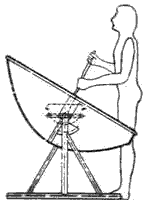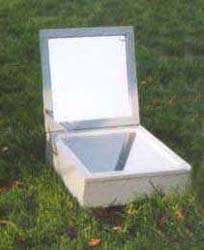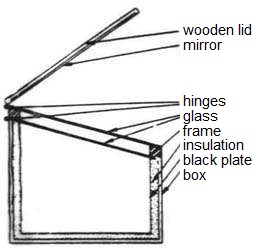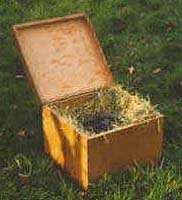Cooking with solar power
The Parabolic solar cooker
The sun has a lot of energy. Every square meter perpendicular to the sun (on equator for example) receives on a cloudless day about 1000 Watt.
This is equivalent to the largest burner on a gas stove. Cooking on the energy of the sun is therefore very well possible if the energy of a large area is aimed at a single point. This concentration of light results in the creation of a parabolic cooker. The parabolic cooker consists of a parabolic mirror that concentrates the solar rays on a single point where a cooking pot is placed.
The WOT has a parabolic cooker of the type SK-14, A solar cooker developed Dr.Ing. D. Seifert. Dr. Seifert is affiliated with the Non-profit development organisation EG-Solar in Germany. The SK-14 has a parabolic reflector (mirror) that concentrates sunlight onto a mat black pot of 12 liters. The pot absorbs the solar rays and heats the water to boiling point. For example, two liters of water is boiling in around 18 minutes. With the parabola cooker you can cook, bake, roast and even fry food. Next to cooking is the parabola cooker also suitable for sterilizing or distilling water.
Safety
The design of the SK-14 mitigates many of the downsides of earlier parabola cookers. By choosing a short focal distance the risk of getting burned or blinded by the concentrated light is small.
Construction
The cooker is robust and simple in construction. The frame can be made from many materials, this allows the design to be adapted to locally sourced materials and manufacturing techniques. The reflector is made from specially treated and very durable (in excess of 15 years) high polished aluminium strips. The SK-14 can, combined with an insulated box, provide food for 15 people. The cooker can be used from one hour after sunrise until one hour before sunset.
The SK-14 is used in around 50 countries. In many of these countries the SK-14 is produced by local workshops (Ecuador, Colombia, Peru, Bolivia, Argentina, Uganda, Congo, Nepal, India, and many others) At least 2000 are in active use.
The cooking box
The cooking box is a well insulated box with a double glazed window. The window allows sunlight to enter the box. The box is painted black to absorb the solar rays. When a pot is placed into the box it is heated by the solar energy that is captured. To increase the possible temperature (beyond 100 degrees celsius) inside the box an mirror can be added to the lid of the box. This mirror directs more solar rays into the box. The cooking box can be made using locally available materials, making it accessible to many communities. A prime advantage of the cooking box is the absence of the need for firewood.
The cooking box has many downsides which inhibit widespread use. The glass and mirror can be difficult to source and be relatively expensive compared to the other materials used for the cooking box. More importantly, the cooking box requires a change in cooking habits. It is for example not possible to stir the pot during cooking.
Solar cookers are only effective when there is a lot of sun available. This means that they are most effective at the hottest moment of the day. While this is when many communities are resting. It is not possible to cook a hot meal in the morning or evening. Besides, the cooking box can’t replace all functions of a wood fire, like providing warmth, amusement and bug-repelling smoke.
The hay box
Cooking on solar energy is only possible when the sun is shining. To make it possible for people who cook using the sun to have a hot meal in the evening a so called hay box can be used.
The principle is quite simple, the haybox is an insulated box to keep the food warm for a long period of time. One can make a hay box by filling a wooden box or basket with blankets, sheep wool, hay or any other insulating material that is locally available. within this insulation the pot with the freshly prepared hot meal is placed. The insulation will keep the food warm long after cooking has finished.
Another advantage of the box is that the food stays warm, and thus continues to slow cook. For example, when boiling rice on the solar cooker for 5 minutes, the rice can be placed in the hay box and after 30 minutes the rice is done. Meanwhile, the solar cooker can prepare another meal.
The principle is quite simple, the hay box is an insulated box to keep the food warm for a long period of time. One can make a hay box by filling a wooden box or basket with blankets, sheep wool, hay or any other insulating material that is locally available. within this insulation the pot with the freshly prepared hot meal is placed. The insulation will keep the food warm long after cooking has finished.
Another advantage of the box is that the food stays warm, and thus continues to slow cook. For example, when boiling rice on the solar cooker for 5 minutes, the rice can be placed in the hay box and after 30 minutes the rice is done. Meanwhile the solar cooker can prepare another meal.





